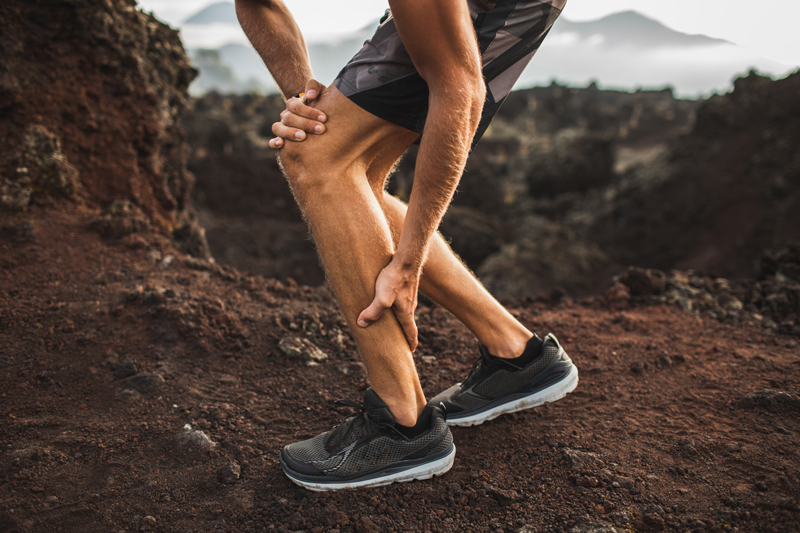This is the longest tendon in your body. It links the heel bone behind the ankle to the calf muscles. When the latter contract, there is pulling on the tendon, leading the foot to point down. This is how people can stand on their toes.
When you have tendonitis, you feel pain right above the back of the heel. Usually, there’s also calf tightness. The tendon in the area affected can appear thick and feel tender. There can be some pain when you rise on your toes or even when you walk.

When the tendon is continuously strained or stressed, it gets irritated and eventually inflamed. In rare cases, it has been known to rupture. Runners often struggle with this condition, which is also increasingly common with age. Over time, wear and tear leads to tendon fiber weakness.
The most frequent cause, however, is overpronation. When you roll your foot inward too often or excessively, the lower leg rotates internally. This exerts pressure on the calf muscles, which leads to overstretching of the Achilles tendon, which in turn leads to inflammation.
- Gymnastics
- Running
- Tennis
- Baseball
- Dance
- Volleyball
- Football
- Softball
- Basketball
- Instant and severe pain in case of ruptures
- Pain above your heel
- Tenderness
- Stiffness
- Swelling
- Popping or snapping noise in the joint

Foot orthotics can help optimize joint movement, improve your foot function, and support your foot to enable the tissue to heal. Limiting the strain or pressure on the Achilles tendon can be critical to recovery. Evidence suggests foot orthotics can help with this by keeping excessive movements under control. If left unchecked, they can cause excessive load on the tendon or twisting.
The right method of shock absorption is also critical in minimizing stress on the tendon. This is best achieved through appropriate shoes and foot orthotics.

Every pair of custom orthotics is made with lifestyle factors, biomechanics, and individual needs in mind. All of these factors are considered carefully, and the orthotics are designed to meet your specific needs.
Orthotics assist in rectifying excessive pronation. By wearing them, you can reduce the strain on the tendon or at least prevent exacerbation of the issue, minimizing the risk of tendon rupture. Some orthotics are appropriate for athletic footwear, while others are better for everyday shoes.
The quality and price of orthotics on the market always come with a great deal of variability. Custom orthotics are the better option as the comfort level will be higher. This, in turn, is likely to make them more effective in mitigating the condition and reducing pain.
Orthotics are just part of the solution. Runners should take care to load the tendon properly. It’s best to consider a plan for returning to running if you are a runner as part of the treatment. Usually runners that follow a progressive loading program will return to their normal training level faster.
Orthotics can take some getting used to, and this needs to happen gradually. Wear them for just one or two hours a day the first few days. Your feet need time to adjust to them.
It can take up to a month for them to start feeling normal. After about a week or two, you should be able to wear them all day without experiencing discomfort.
In addition to orthotics, gentle stretching exercises of the calf muscles and the Achilles tendons are recommended. Before you exert yourself, warm up with exercises. Perform them slowly and gently move into the stretch. If you feel pain, stop immediately. You should only perform them up to when you feel a slight pull.
If the condition is particularly painful, avoid running, sprinting, or doing anything else that exacerbates the problem.
You can reduce inflammation by taking non-steroidal anti-inflammatory drugs and putting ice on the tendon for 20-30 minutes. Ice packs can help a lot in the acute stage.
To hold the tendon steady, you could wear a restrictive ankle boot. This is recommended in severe cases and gives the tendon time to heal. The boot is typically worn for about two months.
An orthopedist can prescribe slowly absorbed steroid injections. They are especially useful for peri-tendinitis, which is where the sheath around the tendon is inflamed.
Your medical practitioner may recommend orthotic use for both treatment and prevention of Achilles Tendonitis. With the proper use and care, orthotics can allow you to minimize the likelihood of recurring Achilles Tendonitis and get you back to normal activity.
Want to learn more? Fill out the contact form below or call us for a consultation with one of our team.
